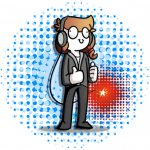
Welcome to an evolving world, and an evolving “book.”
I began writing this book in 2017 with college students in mind. Since then, this text has expanded with years of teaching and collecting responses from students and with more media content. In 2020 we even began integrating student media pieces into this book through our iVoices Student Media Lab. Frankly, calling this a book has begun to feel awkward. If you are a college student, this means that a lot of the content in this book is like social media itself, created and interpreted by your peers using social networking sites like Snapchat, TikTok, Facebook, YouTube, LinkedIn, Reddit, Instagram, and more. It is drawn from the web, including blogs, videos, social media posts, and comments, on fixing cars, following a favorite band, exploring fashion, search engines, and maps that let you mark places. If visitors can weigh in or post their input for others to see, it’s social media, and this book may cover it.
A Note on Impermanence
Many books pretend permanence. This one is unusual in acknowledging that books today – indeed any written information today – will not hold steady value for long. The value of this webbook is directly proportional to the human attention it can manage to sustain.
All informational content today, and particularly online content, is comprised of structures built on shifting foundations. Books, and especially online books, are like the New Jersey beaches I grew up on. On those beaches it is easy to forget that the sands beneath treasured the boardwalks and evening bingo games are drifting into the sea, to settle on ocean floors and other shores.
In the case of this book, the sands on which it is built are always shifting and changing; some of the channels that will suck them away fastest are already in view. First we will lose the hyperlinks, as one, then a few, then many links lead to disappeared pages; indeed I wouldn’t be surprised if a link or two is already broken today on the first day of publication. Second, the platform on which this book is published could be compromised. (We hope not. As an Open Educational Resource drawn from open source development, Pressbooks has an advantage over other proprietary platforms. But things happen.) Third and last, this book’s truths will be cast into doubt as new information emerges around situations about which I’ve written.
I will do my best to keep this book relevant through all of these shifts. And I hope readers will find my writing voice human enough to contact me and alert me when something has slipped out of place.
Acknowledgments
The above caveats notwithstanding, this book has value, and truths, and evidence of the interaction of people with people and with technologies and information. The University of Arizona’s School of Information and College of Social and Behavioral Sciences were the incubators for insights in this book, and students and graduate assistants in the eSociety class Social Media and Ourselves helped it grow. For audiovisual content, I am indebted to spectacular repositories offered via Creative Commons, Wikimedia Commons, Flickr, and Pixabay. I am indebted to open source developers of platforms like Pressbooks, and the University of Arizona Libraries for negotiating their use for faculty at UArizona. I am especially grateful to the Center for University Education and Scholarship, who have funded this book’s migration to Pressbooks and its opening of authorship to students.
How to read this book
This “webbook” is currently hosted on Pressbooks. If it looks to you the way it does to me when I preview it, the menu – a stack of lines icon – at your upper left will drop down to show you the book’s major Parts, which can then be expanded with a + sign to show you the chapters within each part. The arrows at the bottom also help you navigate to the next chapter.
Below is more information on Pressbooks if you need it.
You can learn the most about social media through this text if you perform, as you read, some critical self-reflection – that is, intense inward examination – of your own use of online social networking technologies. What do you do online, and why? Really? What makes that a good idea? Is it possible it’s not a good idea? Why does that process look as it does? Can you envision it working differently? I invite you to critically engage with the content covered in this book. To examine social media critically, you will need to challenge your own beliefs and practices, as well as social norms, institutions, corporations, and governments.
To accustom you to the student content appearing in this book, here is an example of how a student participated in our iVoices Student Media Lab, analyzed social media appearing on their screens, and integrated their own conclusions:
Case Study: I Already Know You – Social Media, Society, and Surveillance
Student Content
It seems the more and more we put ourselves online, the more worried we become as a society over our information. From scary sayings such as “once online, it’s online forever” and other fearmongering absolutes, it seems we are teaching each other to fear the internet. A notion of “we know too little and they know too much” premediating online. Self imposed intimidation as I would call it.
However, the internet isn’t this cold, imposing force taught to us. In many ways, it can be more intimate than the physical world. One such way is the layers of electronic intimacy as coined by Yang et al where individuals look through potential new partners’ online social media accounts to garner a better understanding of who they are. Through this process individuals discover the other’s interests and begin online conservations with a level of understanding that physical interaction would take multiple conservations to get too. In a sense, online platforms allow us to cut through superficial content such as “nice weather” and get straight to genuine conservations.
In both the physical and online world we have a multitude of identities. We have our academic, professional selves in which we treat each other conservatively. Our friendly selves in which we show our interests and passions more openly to a select number of individuals and so on and so forth. The only difference in this sharing of identities is that in the physical world, you can only show one at a time – online you can show them all off at once. LinkedIn = professional, FB = friendly, and so forth.
Speaking about celebrities, the online world has changed the way “normal” and public figures talk to one another. Coined by Graeme Turner, there has been a noticeable movement of celebrities trying to appear relatable and vice versa with individuals trying to portray themselves as grander than life itself – “the demotic turn in celebrity culture.” Big names are being more responsive to fans and thus becoming more reachable and fans or those who don’t necessarily carry the status of “famous” are becoming more bold in reaching out and behaving as if they do – some even achieving the status itself. Past, physical barriers of social status have been removed online. Anybody can reach out to anybody online and possibly start a new relationship with them – the ultimate form of intimate opportunity.
So yes, I already know you and as such, I already think we could be good friends.

About the author
Bombastic! Enthusiastic! (And possibly a caffeine addict…) Jacquie is a girl with a bubbly personality, wanting to learn all and do all if possible. She loves all things creative and has had experience with almost all forms of digital medium. She is a certified radio operator, a past news anchor, a self-made artist, and so much more!
Respond to this case study…This student’s audio story describes her a connection online with a mentor whose livestreams taught her and other students artistic techniques, for free. The benefits to all the participants in this case are clear, but what are the potential benefits to the “streamer” mentor? What traditional and historic roles does this kind of teaching continue or disrupt, and how?
about the questions in this ebook
Enjoy Humans R Social Media.
Gratitude
Many thanks to the University of Arizona iSchool, College of Social and Behavioral Sciences, and Center for University Education and Scholarship, along with Ellen Dubinsky of UA Libraries, Amy Song of Pressbooks, our partners at UA Digital Learning, and especially to Open Pedagogy specialist Cheryl Cuillier of UA Libraries, for supporting this work and the project and labor behind it.
Tremendous thanks also to the media lab students Maria José Garcia, Lizette Arias, Gabe Stultz, Jacquie Kuru, and Kathryn Millar for sharing their skills with our classes; to our invaluable TAs Ally Fripp and Sam Winn; to students in our classes; and to our excellent team of interns who worked tirelessly to integrate these student stories, including Randi Baltzer, Mario Villa, Jasmine Torrez, Crystal Brannon, Kaitlin Butler, Molly Ingram, Jenn Jones, Paige Carlson, and especially team lead Emily Gammons.
My work in this book is dedicated to my son and daughter, whose navigation of social media today is a continuous inspiration; and to Andre Newman, a friend lost too soon. ~ Professor Diana Daly
Media Attributions
- Children playing in sand on beach © Hillebrand Steve, U.S. Fish and Wildlife Service is licensed under a Public Domain license
- image-6042da350c2bd © Jacquie Kuru is licensed under a CC BY (Attribution) license
- NB_image-5fc94a02e3549 © Noe Becerra adapted by Randi Baltzer is licensed under a CC BY (Attribution) license
- CUES_logo




